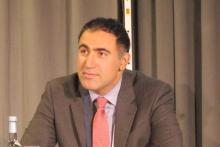Copenhagen – Among older adults with acute myeloid leukemia, the combination of a drug-antibody conjugate and hypomethylating therapy was associated with high complete remission rates.
In a phase I study of 53 patients (median age 75 years) with AML, the combination of vadastuximab talirine and a hypomethylating agent (HMA), either azacitidine or decitabine, was associated in 49 efficacy-evaluable patients with a 71% rate of composite complete remission (CR) and complete remission with incomplete recovery of counts (CRi), reported Dr. Amir Fathi from the Massachusetts General Hospital Cancer Center in Boston.
“This high remission rate in this traditionally high risk group and difficult to treat population is very compelling. Response rates were higher, and were achieved more quickly than would be expected from historical data associated with HMA therapy alone,” he said at a briefing at the annual congress of the European Hematology Association.
Many older patients with AML may not be able to withstand the rigors of cytotoxic chemotherapy, and these patients are often treated with hypomethylating agents or other low-intensity therapies, Dr. Fathi said.
Vadastuximab talirine is an antibody-drug conjugate designed to deliver a cytotoxic agent to myeloid leukemia cells, and in preclinical studies has been shown to enhance the cytotoxic effects of HMAs when given in combination.
Dr. Fathi reported preliminary data on 53 patients enrolled in a phase 1 study of the safety, tolerability, pharmacokinetics, and antileukemic activity of vadastuximab in combination with an HMA.
They enrolled adults with good performance status (Eastern Cooperative Oncology Group 0 or 1) who had CD33-positive AML and had declined intensive chemotherapy. They were given vadastuximab 10 mg/kg in an outpatient intravenous basis every 4 weeks on the fifth day of a 5-day HMA regimen,
Patients who were observed to have a clinical benefit could continue on treatment until relapse or unacceptable toxicity.
Of the 53 patients enrolled, 19 had adverse cytogenetic risk, and 30 had intermediate risk. The majority of patients (48) had not previously been treated for AML, and 5 had received prior low-intensity therapy for the myelodysplastic syndrome.
A total of 49 patients had sufficient data for the efficacy evaluation, and among these patients the composite CR/CRi rate was 71%; the rates of CR/CRi were similar whether the partner HMA was azacitadine or decitabine.
The overall response rate was 76%, with responses seem among higher-risk patients, including remissions in 16 of 22 patients with underlying myelodysplasia, and in 15 of 18 patients with adverse cytogenetics.
In addition, 8 of 19 patients with a CR, and 5 of 15 with a CRi met the definition for minimal residual disease.
Dr. Fathi reported early overall survival results, which he noted were still evolving. The estimated median overall survival for the first 25 patients enrolled in the study was 12.75 months after a median follow-up of 12.58 months.
The median relapse free-survival was 7.7 months. As of last follow-up, 27 patients were alive and remained on study.
The 30-day mortality rate was 2%, and the 60-day rate was 8%.
The most common treatment-related adverse events of any grade occurring in 20% or more of patients were fatigue, thrombocytopenia, nausea, febrile neutropenia, constipation, and anemia
The most common grade 3 or greater treatment-emergent adverse events were febrile neutropenia, thrombocytopenia, neutropenia, anemia, and fatigue.
In an interview, Dr. Fathi said that he has been very encouraged by the results thus far.
“This is a traditionally high-risk patient population. Even with a conventional induction cytotoxic chemotherapy, rates of remission in this population are relatively lower, so if the remission rates pan out in a larger population, I would say it competes and possibly supersedes what you would expect in an older population,” Dr. Fathi said.
Asked whether it might be possible to boost outcomes further with additional therapies, he said that “I’m not sure if there is much more improvement over what we are already seeing; a rate of 70-something percent among older adults with AML is quite good.”
“I like this ‘Trojan-horse’ approach to treating AML,” commented Dr. Anton Hagenbeek, professor of hematology at the Academic Medical Center, University of Amsterdam, who moderated the briefing.
A randomized phase III trial of vadastuximab talirine and HMA therapy is currently enrolling patients.
The study was funded by Seattle Genetics. Dr. Fathi reported no relevant disclosures.


